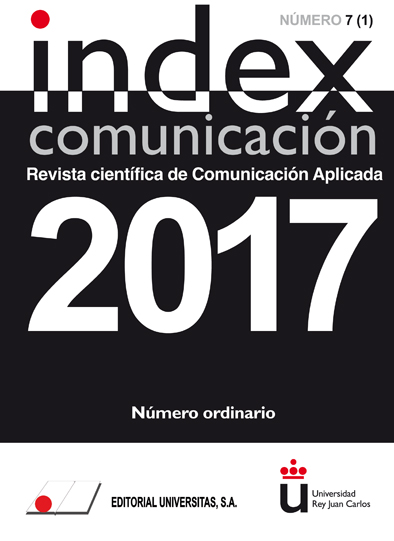Fiction and reality: comparative analysis between Campoamargo (in ‘Mar de plástico’ serie) and El Ejido, Almería
Keywords:
Cultivation Theory, Identification, Cultural Diversity, TV fiction, Mar de Plástico, El EjidoAbstract
The following investigation carries out a comparative analysis between Campoamargo, a fictitious village made up for the audiovisual product Mar de Plástico, and the town of El Ejido (Almería). It is based on the influence of the television over the society and the Cultivation Theory, as part of the study of the ethnic minorities of the Spanish televisual fiction. The investigation form a case study composed by four main ideas –demography, cultural integration, delinquency and potential for conflict and working activity on greenhouse crops– with one common objective: to establish the level of similarity between the society shown by the fiction and the real society in which is inspired. In order to do it, on one hand the content of the TV series is watched and analysed, and on the other hand, several interviews are done to local people of Almería, where the TV series take place, whom due to their profession they know the reality of the area first-hand. Finally, after both analysis are done by separate, a comparison is done where the main similarities and differences between both scenarios are shown up.
Metrics
References
Aguilera Portales, Rafael (2002): ‘El problema del etnocentrismo en el debate antropológico entre Clifford Geertz, Richard Rorty y Lévi-Strauss’, en Gazeta de Antropología, 18, 11.
Álvarez Monzoncillo, José María (2011): “Las nuevas televisiones: personalización e individualización”, en J. M. Álvarez Monzoncillo (coord.): La televisión etiquetada, 83-101. Madrid: Ariel.
Ameigeiras, A. y Jure, E. (compls.) (2006): Diversidad cultural e interculturalidad. Buenos Aires: Prometeo Libros.
Amnistía Internacional (2002): ‘La policía no ofrece protección frente a la violencia racista: el caso de El Ejido’, en Amnistía Internacional (2002): España. Crisis de identidad. Tortura y malos tratos de índole racista a manos de agentes del Estado, 92-97. Madrid: Editorial Amnistía Internacional.
Barker, M. y Austin, T. (2000): From Antz to Titanic. Reventing film analysis. Londres: Pluto Press.
Barlovento Comunicación (2016): Informe Barlovento Comunicación. Análisis del comportamiento del espectador. Madrid: Barlovento Comunicación.
Barlovento Comunicación (2017): Análisis televisivo del año 2016. Madrid: Barlovento Comunicación.
Fernández Casadevante, J. L. y Ramos Pérez, A. (2012): La presencia de las minorías religiosas en las series de ficción nacional. Madrid: Observatorio del Pluralismo Religioso en España.
Garreta Bochaca, Jordi (2003): La integración sociocultural de las minorías étnicas (gitanos e inmigrantes). Madrid: Anthropos.
Gerbner, G.; Gross. L.; Morgan, M.; Signorielli, N. y Shanahan, J. (2002): ‘Growing up with television: cultivation processess’, en J. Bryant y D. Zillmann (comps.): Media effects. Advances in theory and research, 43-68. Nueva Jersey: Lawrence Erlbaum Associates.
Grandío, M. del Mar (2009): ‘El entretenimiento televisivo. Un estudio de audiencia desde la noción de gusto’, en Comunicación y Sociedad, 22(2), 139-158.
Huntington, Samuel Phillips (2005): El choque de civilizaciones y la reconfiguración del orden mundial. Barcelona: Paidós Ibérica.
Igartua, J. y Muñiz, C. (2008): ‘Identificación con los personajes y disfrute ante largometrajes de ficción. Una investigación empírica’, en Comunicación y Sociedad, 21(1), 25-51.
Lacalle, Charo (2008): El discurso televisivo sobre la inmigración. Barcelona: Omega.
Marcos Ramos, María (2013): La imagen de los inmigrantes en la ficción televisiva de prime time. Análisis y recomendaciones para los profesionales. Salamanca: Universidad de Salamanca.
Prado, Emili (2010): ‘Introducción. Contenidos y servicios para la televisión digital’, en Telos, 84, 47-51.
Puebla Martínez, Belén (2012): ‘La comedia de situación en España. Características y evolución del formato’, en B. Puebla Martínez; N. Navarro Sierra y A. I. Íñigo Jurado (coords. y eds.): Ficcionando. Series de televisión a la española, 15-38. Madrid: Fragua.
Puebla Martínez, B. y Navarro Sierra, N (2016): ‘Perspectivas de las teorías clásicas de la comunicación frente a las olvidadas referencias a la actualidad en la telecomedia española’, en index.comunicación, 6(2), 83-99.
Puebla Martínez, B.; Navarro Sierra, N. e Íñigo Jurado, A. I. (coords. y eds.) (2012): Ficcionando. Series de televisión a la española. Madrid: Fragua.
Roda Fernández, Rafael (1989): Medios de comunicación de masas. Su influencia en la sociedad en la cultura contemporánea. Madrid: Centro de Investigaciones Sociológicas.
Solé, Carlota (2001): El impacto de la inmigración en la economía y en la sociedad receptora. Barcelona: Anthropos.
Wolf, Mauro (2001): Los efectos sociales de los media. Madrid: Paidós.
Published
How to Cite
Issue
Section
License
Authors who submit to this journal agree to the following terms:
Authors retain copyright and ensure the magazine's right to be the first publication of the work as licensed under a Creative Commons Attribution-NoComercial 4.0 International License that allows others to share the work with an acknowledgment of authorship of the work and the initial publication in this magazine, with no commercial purpose.
Authors can establish separate additional agreements for non-exclusive distribution of the version of the work published in the magazine (for example, to an institutional repository or publish it in a book), with an acknowledgment of its initial publication in this journal.
It allows and authors are encouraged to disseminate their work electronically (eg, in institutional repositories or on their own website) prior to and during the submission process, as it can lead to productive exchanges, as well as a citation more early and most of the published work (See The Effect of Open Access).















